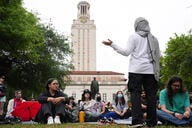You have /5 articles left.
Sign up for a free account or log in.
A study group convened by the University of Wisconsin at Madison in the wake of the violence in Charlottesville, Va., last August released a report last week documenting the university's history of racism and exclusion, including two student organizations in the early 20th century that were called Ku Klux Klan.
Two student organizations took the name “Ku Klux Klan” between 1919 and 1926, the report found. One group was associated with the national white supremacist group. The other was an interfraternity society unattached to a broader organization. These groups were widely uncontroversial, according to the report.
The study group recommended the university postpone discussions about renaming campus spaces and focus on addressing history and enforcing change.
"We insist that the history this connection represents must not be obscured or ignored but instead confronted and addressed," the report said. "At this time, we resist the impulse to resolve this sense of shock by purging the names from our campus. It may be that, after thoughtful community deliberation, the campus will find it desirable or necessary to change the names of some facilities."
Some buildings around campus bear the names of Klan members, including the artist Porter Butts and the actor Fredric March, whose names are displayed on facilities in the Memorial Union. The report considers the notion that Klan membership "reflected the climate of the era," and that youthful decisions of members shouldn't outweigh their subsequent contributions. Butts became a local and national leader in the organization of student unions, where he advocated for policies of inclusion. He is a recipient of the college's highest honor, the Distinguished Alumni Award. March was an award-winning actor who fought the persecution of Hollywood artists, many of them Jewish, in the 1950s.
While the report focuses on Madison's Klan groups, it notes that the college's culture of exclusion wasn't the work of a few but was "a pervasive culture of racial and religious bigotry, casual and unexamined in its prevalence, in which exclusion and indignity were routine, sanctioned in the institution’s daily life, unchallenged by its leaders."
The university is now working to expand curricular offerings on underrepresented cultural identities and to diversify the faculty and the student body, according to a Thursday statement by Rebecca Blank, university chancellor. The college committed $1 million to a public history project that elevates those who experienced and fought prejudice on campus. To increase diversity among faculty, Wisconsin Madison gave funding to ethnic studies divisions to hire four new members, and the university intends to direct additional resources to recruiting top scholars from underrepresented groups. The university is also launching programs to increase accessibility for first-generation and lower-income students, including the Badger Promise for first-generation transfers and Bucky’s Tuition Promise for low and moderate-income Wisconsin students.




